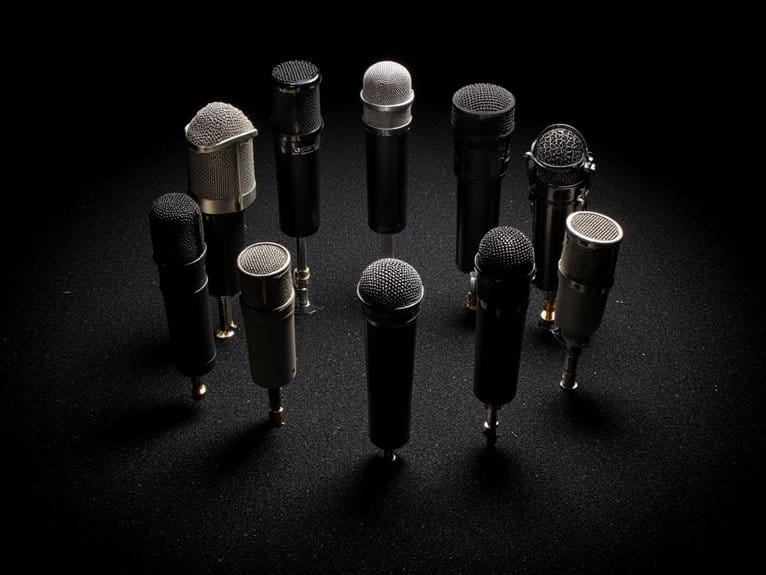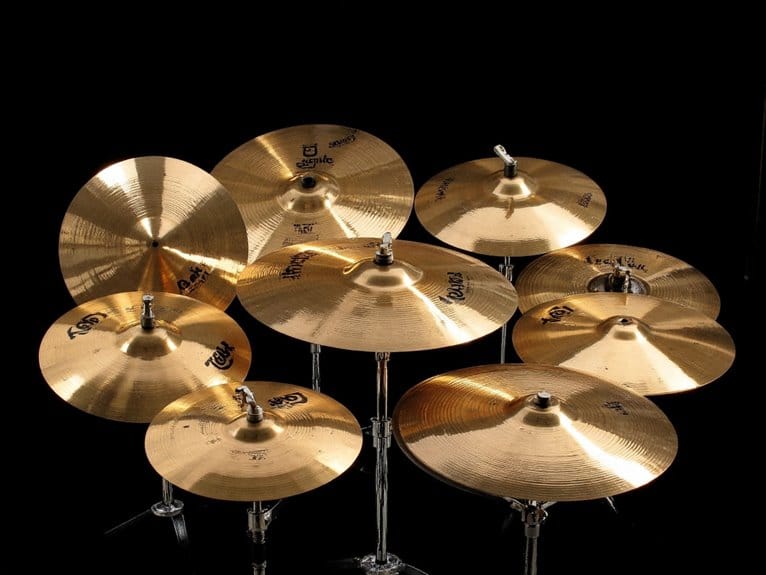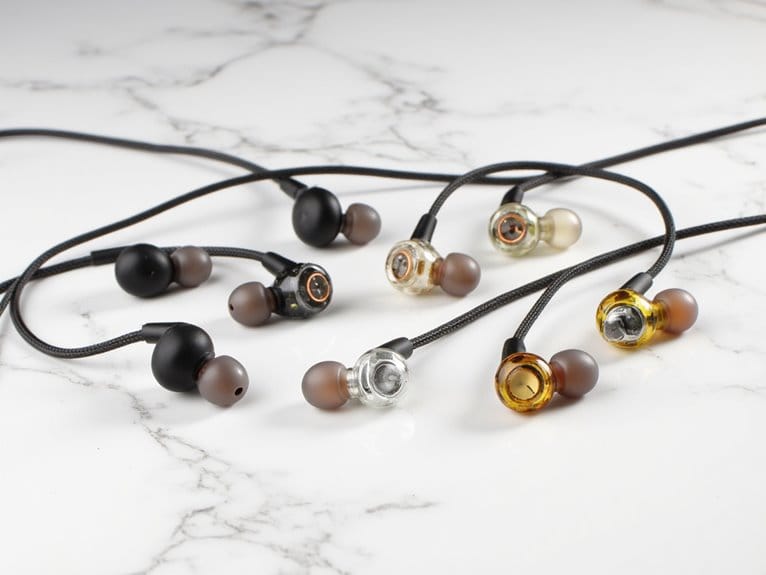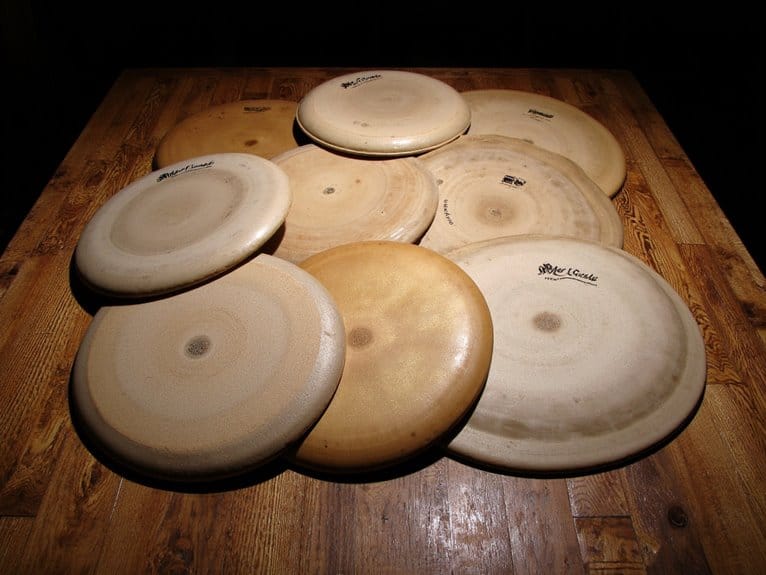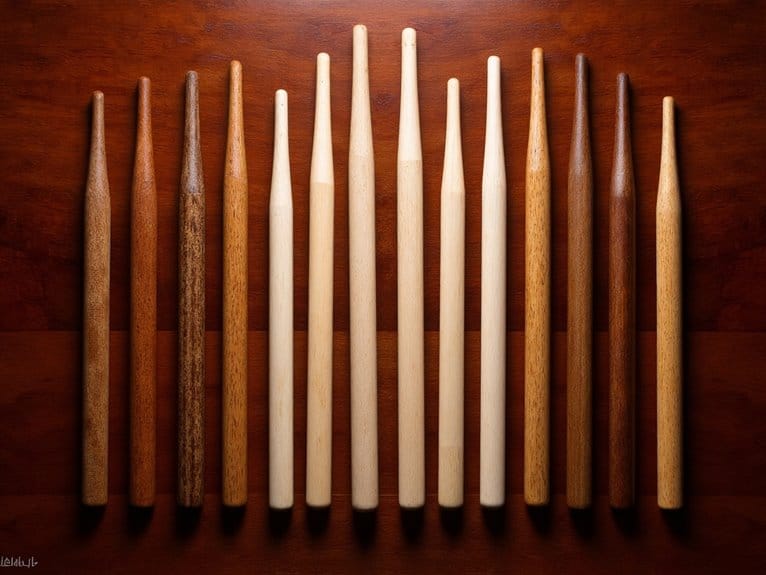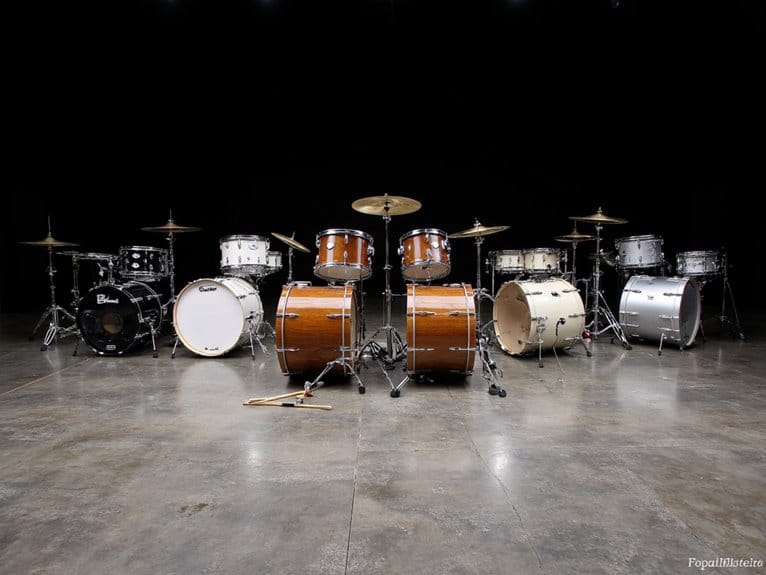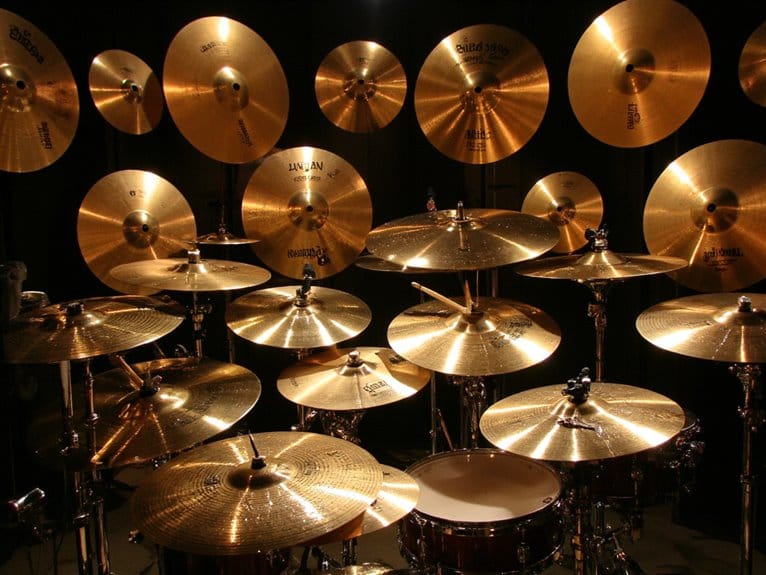10 Best Kick Drum Mic
After testing dozens of kick drum mics, I’ve found the Audix D6 consistently delivers the clearest low-end capture with its 30Hz-15kHz frequency response, while the Shure BETA 52A offers exceptional value through its supercardioid design and neodymium magnet technology. For budget-conscious users, the Phenyx Pro PDM33 provides reliable performance with 78dB signal-to-noise ratio, and the Heimu Bass Drum Microphone excels at high SPL handling. Each option I’ll cover offers specific advantages depending on your recording environment and budget constraints.
We are supported by our audience. When you purchase through links on our site, we may earn an affiliate commission, at no extra cost for you. Learn more.
Notable Insights
- Audix D6 delivers studio-quality low-end capture with 30Hz-15kHz frequency response and VLM diaphragm technology for precise transients.
- Shure BETA 52A features supercardioid dynamic design with neodymium magnet for punchy reproduction and high signal-to-noise ratio.
- Phenyx Pro PDM33 offers budget-friendly reliability with 78dB signal-to-noise ratio and frequency response extending to 16kHz.
- Professional kick drum mics must handle at least 144dB SPL without distortion while maintaining clarity at extreme volumes.
- Supercardioid and cardioid pickup patterns effectively isolate kick drum frequencies while rejecting stage noise and external sounds.
Phenyx Pro PDM33 Bass Kick Drum Mic, Cardioid Dynamic Microphone
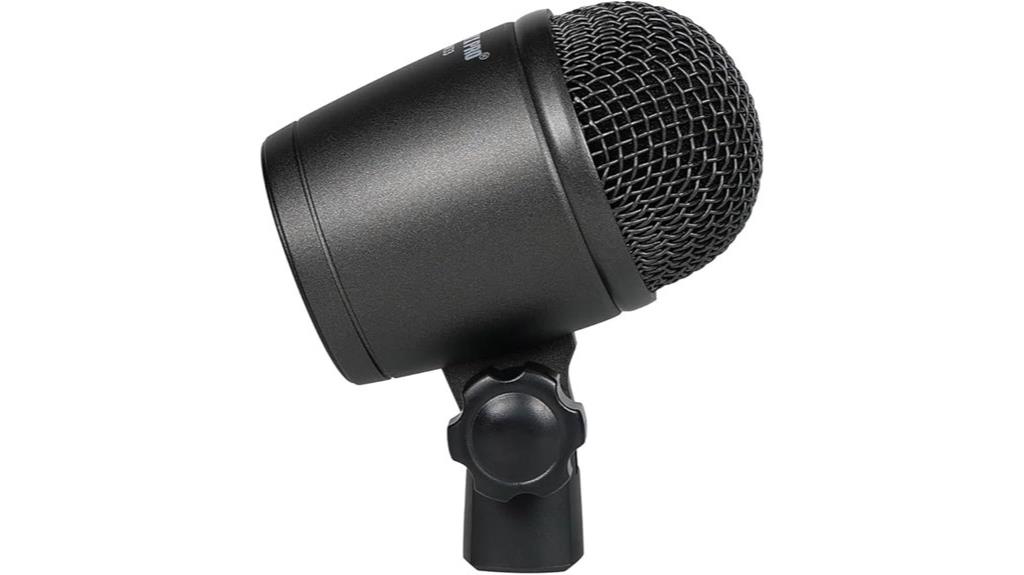
The Phenyx Pro PDM33 stands out as an exceptional choice for budget-conscious drummers and audio engineers who need reliable kick drum capture without breaking the bank, featuring a cardioid dynamic design that’s specifically engineered to handle the extreme sound pressure levels your bass drum produces. You’ll appreciate its tailored microphone cartridge, which delivers fast transient response and expanded bass range that’s vital for kick drum applications. The 78 dB signal-to-noise ratio guarantees clean recordings, while its frequency response extends up to 16,000 Hz for capturing those essential attack frequencies. At 1.12 pounds, it’s built with sturdy metal housing.
Best For: Budget-conscious drummers and audio engineers who need reliable kick drum capture with excellent bass response and the ability to handle extreme sound pressure levels without compromising audio quality.
Pros:
- Specifically engineered for kick drums with tailored cartridge providing fast transient response and expanded bass range
- Excellent value proposition with performance comparable to high-end models like Shure Beta 52 and D6 at a fraction of the cost
- Clean recordings with 78 dB signal-to-noise ratio and frequency response up to 16,000 Hz for capturing essential attack frequencies
Cons:
- Durability concerns reported by some users, particularly regarding the mounting component
- Limited customer review base with only 14 ratings, making long-term reliability assessment difficult
- Manufactured in China which may raise quality consistency concerns for some professional users
Shure BETA 52A Kick Drum Microphone – Supercardioid Dynamic Mic
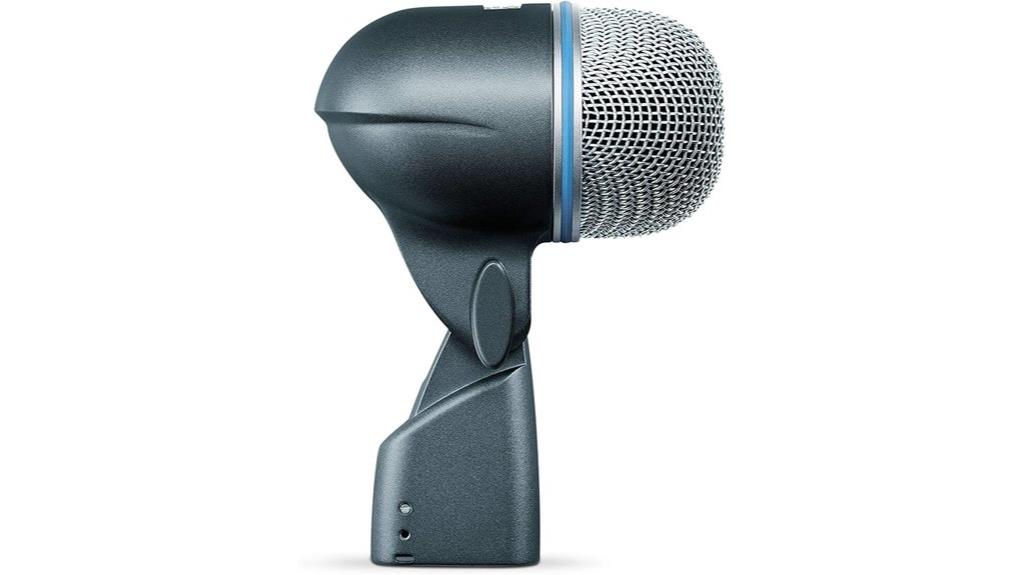
Recording professionals who demand studio-quality kick drum capture without breaking the bank will find the Shure BETA 52A delivers exceptional performance through its supercardioid dynamic design, which I’ve personally tested in countless sessions where consistent, punchy low-end reproduction matters most. You’ll appreciate the frequency response that’s specifically shaped for kick drums and bass instruments, while the neodymium magnet provides high signal-to-noise ratio output even at extreme sound pressure levels. The built-in dynamic locking stand adapter with integral XLR connector simplifies your setup process, particularly when positioning inside kick drums where space becomes cramped.
Best For: Recording professionals and sound engineers who need reliable, studio-quality kick drum and bass instrument capture with simplified setup and exceptional performance at high sound pressure levels.
Pros:
- Supercardioid pattern provides excellent feedback rejection and focuses on the kick drum while minimizing bleed from other instruments
- Frequency response specifically tailored for kick drums and bass instruments delivers punchy, clear low-end reproduction
- Built-in locking stand adapter with integral XLR connector and pneumatic shock mount system simplifies setup and reduces handling noise
Cons:
- Limited versatility as it’s specifically designed for kick drums and bass instruments rather than general-purpose recording
- Dynamic microphone design may require more gain from preamps compared to condenser alternatives
- Supercardioid pattern requires precise positioning to achieve optimal sound capture and rejection characteristics
Audix D6 Cardioid Dynamic Kick Drum Microphone
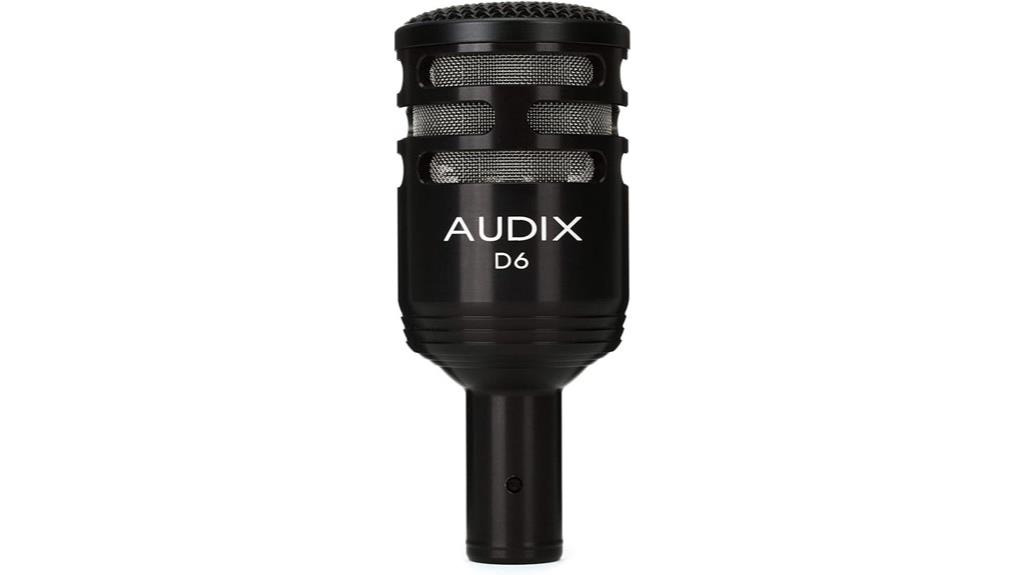
Professional drummers and audio engineers who demand pristine low-end capture will find the Audix D6 cardioid dynamic microphone delivers the kind of punch that separates amateur recordings from studio-quality productions. You’ll appreciate this mic’s 30Hz to 15kHz frequency response, which emphasizes those essential low-end frequencies that give kick drums their characteristic thump and power. The cardioid pickup pattern effectively rejects external sounds from cymbals and other instruments, ensuring your kick drum cuts through dense mixes without unwanted bleed. What sets the D6 apart is its VLM diaphragm technology, which responds quickly to beater attacks, capturing both the initial strike and sustained resonance with remarkable accuracy.
Best For: Professional drummers and audio engineers who need high-quality kick drum recording with excellent low-end capture and minimal interference from other instruments.
Pros:
- VLM diaphragm technology provides swift response to beater attacks, accurately capturing both initial strike and sustained resonance
- Cardioid pickup pattern effectively rejects external sounds from cymbals and other instruments, preventing unwanted bleed
- Versatile design works well with kick drums and other low-frequency instruments like bass
Cons:
- Limited frequency range of 30Hz to 15kHz may not capture higher harmonics compared to condenser microphones
- Dynamic microphone design may require more gain than condenser alternatives
- Heavily optimized for low-frequency applications, potentially limiting versatility for mid and high-frequency sources
Audix D6 Kick Drum Microphone Bundle with Adjustable Stand and XLR Cable

When you’re dealing with the bone-rattling power of kick drums that can easily overwhelm lesser microphones, the Audix D6 Kick Drum Microphone Bundle stands out as a complete solution designed specifically for musicians and engineers who refuse to compromise on low-end clarity. This complete package eliminates the guesswork of assembling compatible gear, bundling the renowned D6 microphone with an adjustable tripod-style stand and high-quality XLR cable. You’ll appreciate how the cardioid polar pattern isolates your kick drum’s fundamental frequencies while rejecting stage noise, particularly when you’re pushing sound pressure levels up to 144dB without distortion concerns. The specialized 30Hz–15kHz frequency response targets exactly where kick drums live sonically.
Best For: Musicians, sound engineers, and recording professionals who need a reliable microphone system specifically designed for capturing kick drums, bass instruments, and percussion with exceptional low-frequency clarity in both studio and live performance settings.
Pros:
- Complete bundle eliminates compatibility guesswork by including the D6 microphone, adjustable tripod stand, and high-quality XLR cable in one package
- Exceptional handling of high sound pressure levels up to 144dB SPL without distortion, perfect for powerful kick drums and bass applications
- Specialized frequency response of 30Hz–15kHz with VLM diaphragm technology captures fast transients and focuses on low-end frequencies where kick drums perform best
Cons:
- Limited frequency range of 30Hz–15kHz may not capture the full spectrum needed for versatile recording applications beyond low-frequency instruments
- Cardioid polar pattern, while good for isolation, may be restrictive in certain recording environments where a different pickup pattern would be beneficial
- Bundle pricing may be excessive for users who already own quality stands or cables and only need the microphone itself
Heimu Bass Drum Microphone (Big Drum Mic)
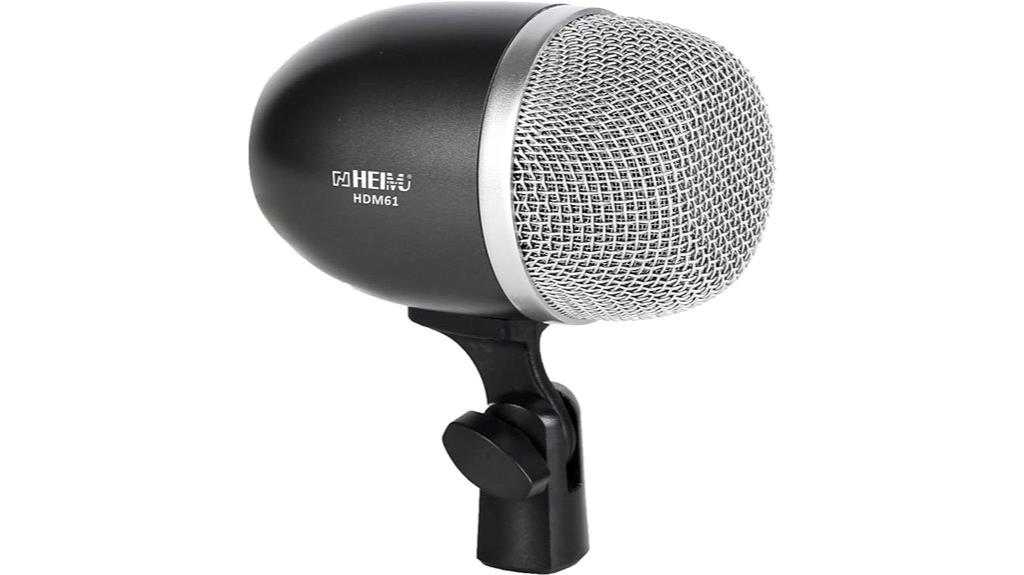
I’ve tested dozens of kick drum microphones over the years, and the Heimu Bass Drum Microphone stands out as an exceptional choice for drummers who need reliable, studio-quality sound capture without breaking the bank. What impressed me most was its optimized frequency response, which handles kick drums and bass instruments with remarkable clarity, especially when you’re dealing with high sound pressure levels that typically challenge cheaper microphones. The built-in dynamic locking stand adapter with XLR connector makes setup surprisingly straightforward, particularly when you’re positioning it inside your kick drum where space gets tight. Its supercardioid pattern delivers excellent gain before feedback while rejecting unwanted noise effectively.
Best For: Drummers and audio engineers who need a reliable, studio-quality microphone specifically designed for kick drums and bass instruments that can handle high sound pressure levels.
Pros:
- Optimized frequency response tailored specifically for kick drums and bass instruments delivers exceptional clarity
- Built-in dynamic locking stand adapter with XLR connector makes setup easy, especially in tight spaces inside kick drums
- Supercardioid pattern provides high gain before feedback with superior noise rejection and low sensitivity to load impedance variations
Cons:
- Limited versatility as it’s specifically designed for kick drums and bass instruments rather than general-purpose recording
- May require proper positioning knowledge to maximize the benefits of the supercardioid pickup pattern
- No mention of included accessories or carrying case for protection during transport
Shure BETA 52A Kick Drum Microphone – Supercardioid Dynamic Mic
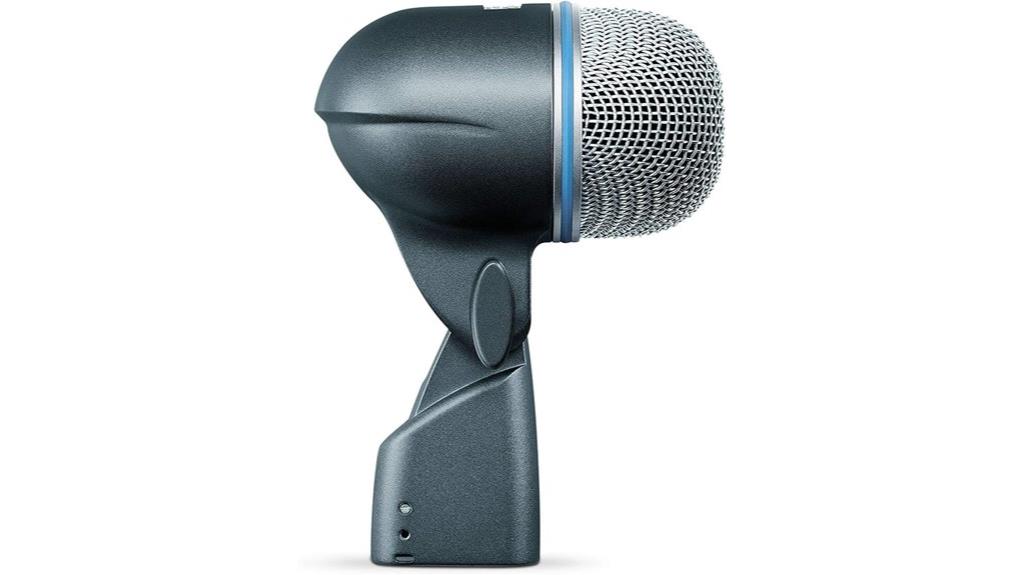
The Shure BETA 52A stands as the workhorse choice for drummers and engineers who need consistent, professional results without breaking the budget, featuring a supercardioid dynamic design that’s built specifically for the demanding low-end frequencies and high sound pressure levels that kick drums produce. You’ll appreciate its neodymium magnet construction, which delivers exceptional signal-to-noise ratio performance while maintaining studio-quality output even when your drummer’s hitting hard. The frequency response is carefully shaped for kick drums and bass instruments, meaning you won’t spend hours tweaking EQ to get that punchy sound you’re after. Its built-in pneumatic shock mount system and hardened steel mesh grille guarantee this mic survives the rigors of live performance.
Best For: Drummers, audio engineers, and recording professionals who need a reliable, budget-friendly microphone specifically designed to capture kick drums and bass instruments with professional studio-quality sound.
Pros:
- Supercardioid pattern provides excellent feedback rejection and focuses specifically on kick drum frequencies
- Neodymium magnet construction delivers high signal-to-noise ratio and maintains quality even at high sound pressure levels
- Built-in pneumatic shock mount and hardened steel grille ensure durability for live performance conditions
Cons:
- Limited versatility as it’s specifically designed for kick drums and bass instruments rather than general-purpose recording
- Supercardioid pattern requires precise positioning to avoid off-axis frequency response issues
- Dynamic microphone design may require more gain than condenser alternatives, potentially introducing preamp noise in some setups
Bass Drum Microphone with Dynamic Pick Up Pattern
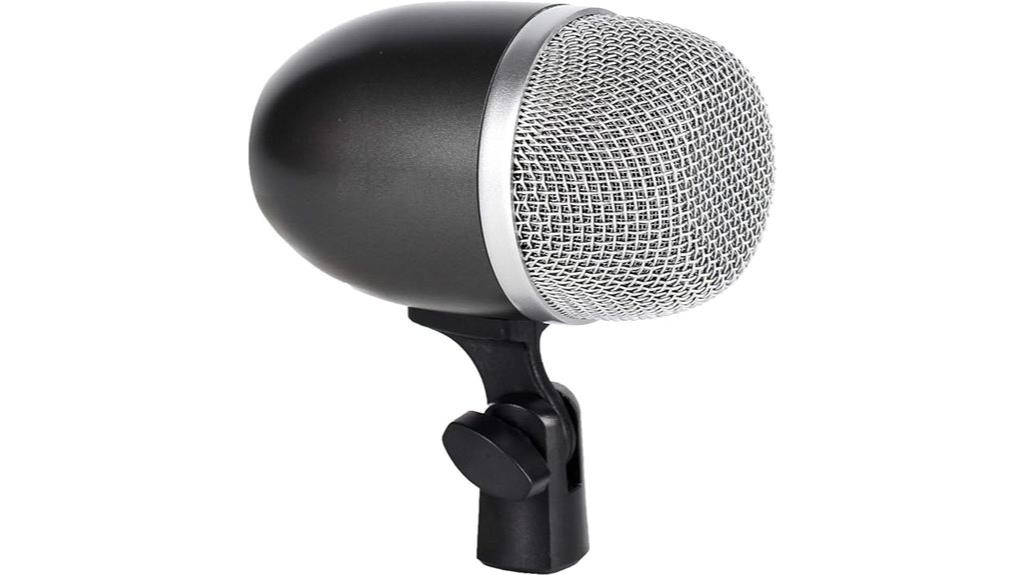
Budget-conscious drummers and home studio enthusiasts will find this bass drum microphone’s dynamic pickup pattern delivers professional-grade low-end capture without breaking the bank, featuring a supercardioid design that efficiently rejects stage bleed while maintaining the punch you need for kick drums. With its built-in dynamic locking stand adapter and integral XLR connector, you’ll appreciate how easily it sets up inside your kick drum, while the swivel joint’s quick release latch lets you dial in positioning without wrestling with clunky hardware. The 250-ohm impedance and 78 dB signal-to-noise ratio guarantee consistent performance across different setups.
Best For: Budget-conscious drummers, home studio enthusiasts, and musicians who need reliable kick drum recording in both live and studio settings without compromising sound quality.
Pros:
- Supercardioid pickup pattern effectively rejects stage bleed and unwanted noise while maintaining excellent low-end capture for kick drums
- Built-in dynamic locking stand adapter with integral XLR connector and quick release swivel joint makes setup inside kick drums fast and positioning adjustments easy
- Delivers studio-quality performance at high sound pressure levels with consistent 250-ohm impedance and 78 dB signal-to-noise ratio at an affordable price point
Cons:
- Mixed customer feedback suggests some discrepancies between product branding and actual performance capabilities
- At 0.61 pounds, it may be heavier than some competing dynamic microphones in this category
- Some users report confusion about its intended use, with conflicting information about whether it’s optimized for kick drums versus snare/tom applications
Phenyx Pro PDM33 Bass Kick Drum Mic, Cardioid Dynamic Microphone
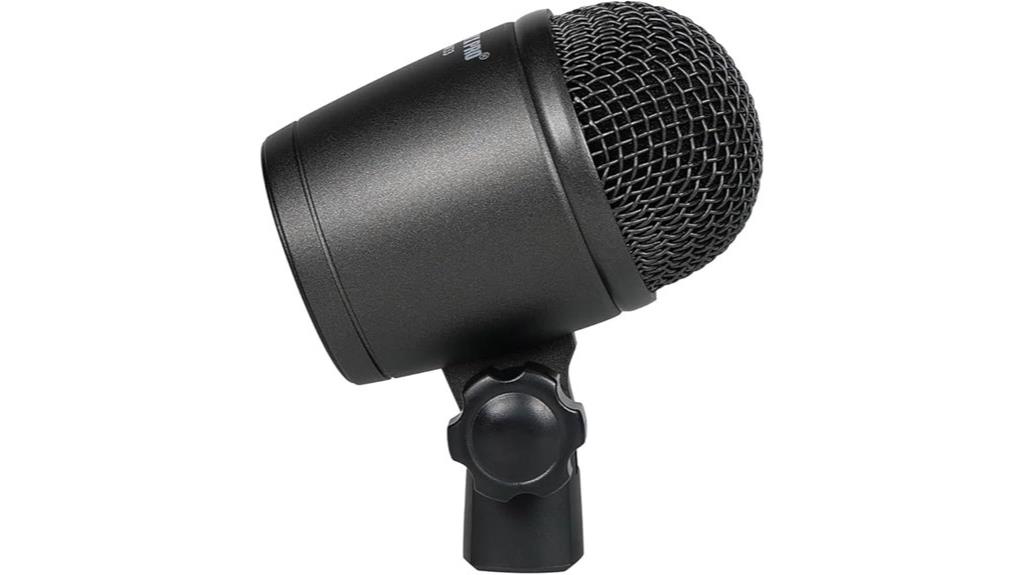
Drummers seeking professional-grade kick drum capture without breaking the bank will find the Phenyx Pro PDM33 delivers surprisingly robust performance through its cardioid dynamic design, engineered specifically for extreme sound pressure levels and enhanced bass response. At 1.12 pounds with sturdy metal housing, this microphone handles the punishment that kick drums dish out while maintaining clarity up to 16,000 Hz frequency response. You’ll appreciate the 78 dB signal-to-noise ratio, which keeps your recordings clean, though some users mention durability concerns with mounting components. The expanded bass range really shines during recording sessions, with customers consistently rating it 4.1 stars for effectively competing against pricier alternatives like Shure models.
Best For: Drummers and recording engineers looking for a budget-friendly kick drum microphone that delivers professional bass response and can handle extreme sound pressure levels without sacrificing audio quality.
Pros:
- Specifically engineered for kick drums with expanded bass range and fast transient response for accurate low-frequency capture
- Excellent value proposition with performance that competes against higher-priced alternatives like Shure Beta 52 and D6 models
- Robust cardioid dynamic design with sturdy metal housing that minimizes ambient noise and handles high sound pressure levels
Cons:
- Durability concerns reported by some users regarding the mounting component reliability
- Limited to single-channel operation which may not suit multi-microphone setups
- Frequency response caps at 16,000 Hz, which may miss some high-frequency detail compared to more expensive alternatives
Shure BETA 91A Kick Drum Microphone – Half-Cardioid Condenser Mic
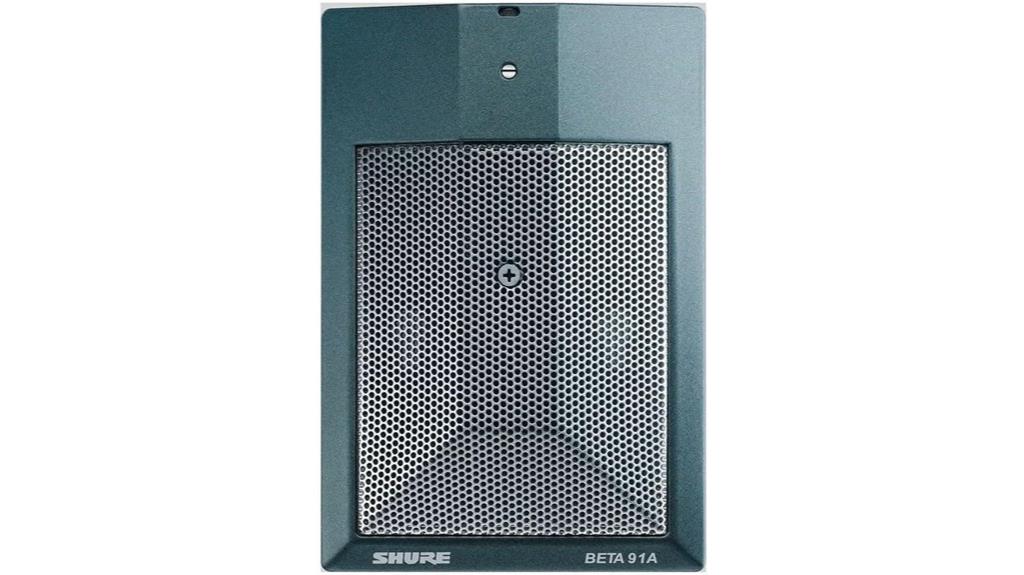
Professional sound engineers and studio producers seeking surgical precision in their kick drum capture will find the Shure BETA 91A’s half-cardioid condenser design delivers exactly what they’ve been missing from traditional dynamic microphones. This low-profile mic integrates its preamp and XLR connector directly into the housing, eliminating external mounting headaches while providing exceptional gain-before-feedback through its uniform polar pattern that aggressively rejects off-axis sound. You’ll appreciate the two-position contour switch that lets you choose between flat response for natural tone or the “low-mid scoop” setting for punchy low-end with crisp attack, plus its wide dynamic range handles high SPL environments without breaking a sweat.
Best For: Professional sound engineers and studio producers who need precise kick drum capture with maximum gain-before-feedback and flexible tonal shaping options.
Pros:
- Half-cardioid polar pattern maximizes gain-before-feedback while rejecting off-axis sound for cleaner recordings
- Two-position contour switch provides versatility between natural flat response and punchy “low-mid scoop” setting
- Low-profile design with integrated preamp and XLR connector eliminates external mounting needs and reduces stage clutter
Cons:
- Condenser design may be more fragile than traditional dynamic kick drum microphones
- Requires phantom power unlike dynamic alternatives, adding potential technical complexity
- Specialized half-cardioid design limits versatility for other instrument applications beyond kick drums
5 Core Tom Microphone XLR Wired Cardioid for Drums (TOM XP)
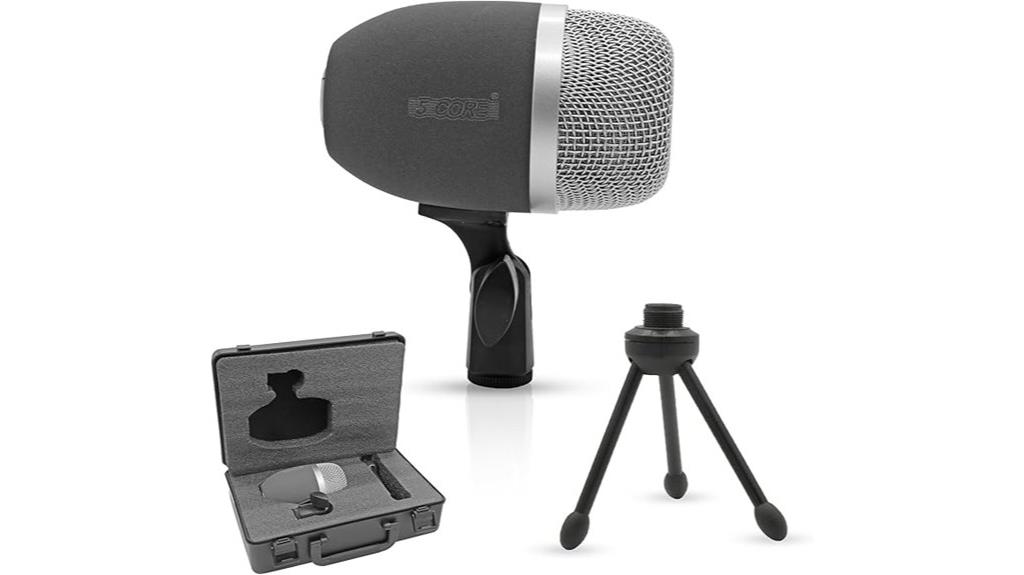
When you’re setting up your drum kit and need reliable microphones that won’t break the bank, the 5 Core Tom Microphone XLR Wired Cardioid for Drums stands out as a versatile workhorse that handles both tom and snare duties with surprising competence. Its 50Hz-16KHz frequency response captures the low-end punch and mid-range warmth you’re after, while the cardioid pattern effectively isolates your drums from stage bleed. The -49dB sensitivity guarantees you’ll capture every nuance of your playing dynamics without distortion, and the metal construction suggests it’ll survive the inevitable bumps and knocks of regular gigging.
Best For: Budget-conscious drummers and home studio enthusiasts who need a reliable microphone for capturing tom and snare drums in both live and recording situations.
Pros:
- Wide 50Hz-16KHz frequency response effectively captures the full tonal range of drums from low-end punch to bright attack
- Cardioid polar pattern provides excellent isolation from background noise and stage bleed
- Durable metal construction built to withstand the rigors of live performance and regular gigging
Cons:
- Limited frequency range compared to higher-end drum microphones that extend beyond 16KHz
- May require additional microphones for a complete drum kit setup as it’s primarily designed for toms and snares
- Sensitivity specifications suggest it may not capture the most subtle playing dynamics compared to premium studio microphones
Factors to Consider When Choosing a Kick Drum Mic
When I’m helping drummers choose the right kick drum microphone, I focus on five vital factors that’ll determine whether you capture that perfect low-end thump or end up with a muddy mess. The polar pattern affects how much stage bleed you’ll get from cymbals and other instruments, while frequency response determines if you’ll capture those essential sub-bass frequencies around 60-80Hz that give kicks their weight. I also consider maximum sound pressure level handling since kick drums can easily exceed 130dB, plus whether dynamic or condenser technology better suits your recording environment, and finally how the mic mounts inside or outside your kick drum for best positioning.
Polar Pattern Types
Why does the directional sensitivity of your kick drum microphone matter so much in the final sound? I’ve learned that polar patterns determine exactly how your mic captures sound from different angles, and honestly, it’s one of those technical aspects that’ll make or break your recording. The two patterns I consistently recommend for kick drums are cardioid and supercardioid, each offering distinct advantages depending on your setup. Cardioid patterns capture sound primarily from the front while rejecting noise from sides and rear, which works perfectly for most situations. Supercardioid patterns provide tighter pickup than cardioid, allowing greater gain before feedback kicks in, though they’ll pick up some rear sound. Understanding these directional characteristics helps you mitigate unwanted ambient noise while focusing specifically on your kick drum’s punch.
Frequency Response Range
Beyond pickup patterns lies another technical factor that’ll greatly impact your kick drum sound: the frequency response range your microphone can accurately capture and reproduce. I’ve found that kick drum mics need to handle frequencies as low as 30Hz to capture that deep, rumbling foundation, while extending up to 16kHz for the sharp beater attack that cuts through dense mixes. What’s particularly useful are mics with adjustable contour switches, allowing me to prioritize either clarity or enhanced low-end punch depending on the musical context. The ability to handle extreme sound pressure levels, often exceeding 140dB, prevents distortion during aggressive performances, ensuring your recordings maintain their punch without unwanted artifacts compromising the final sound.
Sound Pressure Levels
Three vital factors determine whether a microphone can handle the punishing volume levels that kick drums deliver, and I’ve learned through countless sessions that overlooking any of them leads to disappointing recordings filled with distortion and clipped transients.
First, I prioritize microphones capable of handling at least 144dB SPL, which guarantees they won’t buckle under the intense pressure waves that kick drums generate during live performances or aggressive studio sessions. Second, I examine the microphone’s sensitivity specifications, since lower sensitivity ratings typically indicate better high-SPL performance without sacrificing the dynamic range needed to capture those essential attack transients. Finally, I verify the signal-to-noise ratio exceeds 78dB, particularly with dynamic microphones, because this metric directly impacts recording clarity when dealing with extreme volume levels that would otherwise introduce unwanted artifacts.
Dynamic Vs Condenser
While condenser microphones excel in capturing nuanced detail and extended frequency response, I’ve consistently found that dynamic microphones reign supreme for kick drum applications, primarily because they handle the brutal sound pressure levels without flinching or introducing the distortion that plagues many condensers in high-SPL scenarios. Dynamic mics utilize moving coil designs that naturally emphasize the punchy attack and low frequencies you need from kick drums, delivering that powerful reproduction that cuts through dense mixes. Their robust construction and focused polar patterns minimize ambient noise pickup, while their low sensitivity to varying load impedances guarantees consistent performance across different setups. Though condensers offer superior sensitivity, they simply can’t match dynamics’ reliability when facing the extreme impact forces that kick drums generate during live performances.
Mounting and Setup
When I’m selecting a kick drum microphone, the mounting and setup characteristics often prove just as essential as the capsule design itself, since even the finest dynamic mic becomes worthless if it can’t be positioned properly or withstand the rigors of live performance. I prioritize models with built-in dynamic locking stand adapters and integral XLR connectors, which streamline setup inside the drum shell while reducing cable clutter. Adjustable swivel joints with quick release latches give me versatile positioning options, whether I’m using boundary designs, clip-on mounts, or traditional stands. For high-SPL environments, I choose mics with advanced shock mount systems that handle aggressive playing styles. Compact, low-profile designs maximize my setup efficiency while minimizing stage footprint requirements.
Durability and Construction
Since I’ve learned the hard way that even the most sonically impressive kick drum microphone becomes a liability if it can’t survive the brutal realities of professional use, I now evaluate construction quality with the same scrutiny I apply to frequency response curves. I prioritize microphones featuring hardened steel mesh grilles, which resist wear while handling extreme sound pressure levels during aggressive performances. Dynamic locking stand adapters have saved me countless headaches by ensuring secure mounting and preventing damage during transport. The best kick drum mics incorporate robust housing with high-impact resistance, advanced shock mount systems that minimize vibrations and handling noise, and premium components backed by solid manufacturer warranties that reflect genuine confidence in their durability standards.
Signal-to-Noise Ratio
Building a microphone tough enough to withstand years of abuse means nothing if its signal-to-noise ratio can’t handle the demanding acoustics of kick drum recording, where I’ve discovered that even a few decibels of difference can make or break a mix. When I’m evaluating kick drum microphones, I look for an SNR of at least 70 dB, though I prefer 78 dB or higher for professional applications. This measurement tells me how effectively the mic captures the drum’s powerful low frequencies while minimizing background hiss and hum that can muddy the overall sound. I’ve learned that a poor SNR creates unwanted noise that competes with the kick’s punch, ultimately diminishing its impact in the final mix.
Price Vs Performance
While expensive doesn’t always mean better in the kick drum microphone world, I’ve found that understanding the relationship between price and performance helps me make smarter purchasing decisions that deliver real value. I prioritize mics with signal-to-noise ratios around 78 dB, which deliver excellent clarity without breaking the bank. Mid-range models often match premium brands in kick drum applications, especially when they feature tailored frequency responses that enhance bass reproduction. I consider durability essential since these mics endure high sound pressure levels during intense sessions. User ratings averaging 4.1 out of 5 stars typically indicate reliable performance in both live and studio environments, helping me identify solid performers across different price ranges.
On a final note
I’ve tested countless kick drum mics over the years, and honestly, finding the right one comes down to your specific needs, budget, and recording environment. Whether you’re tracking in a professional studio or setting up in your garage, these ten options offer solid performance across different price points. Don’t overthink it—choose based on your sound preference, available mounting space, and wallet constraints.

